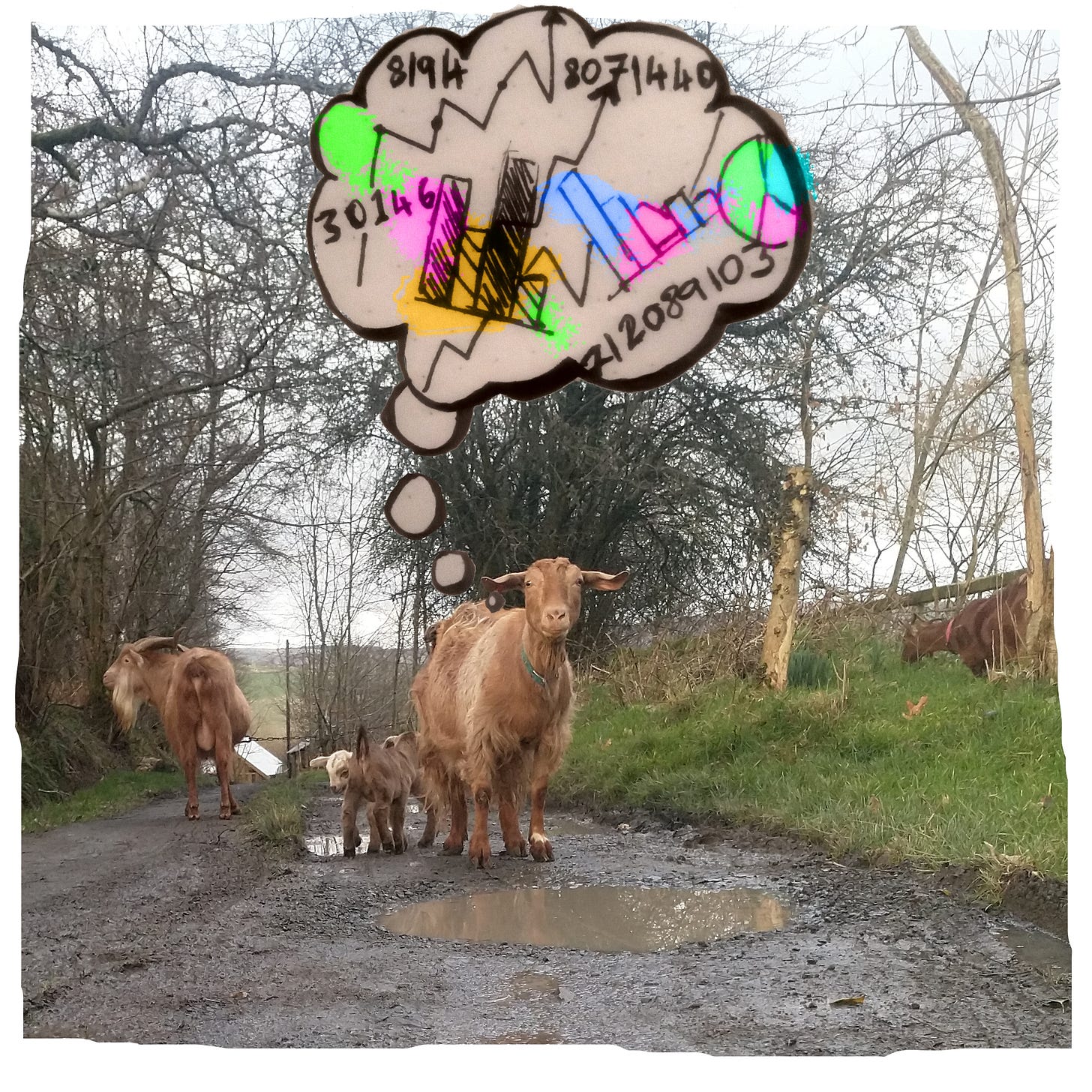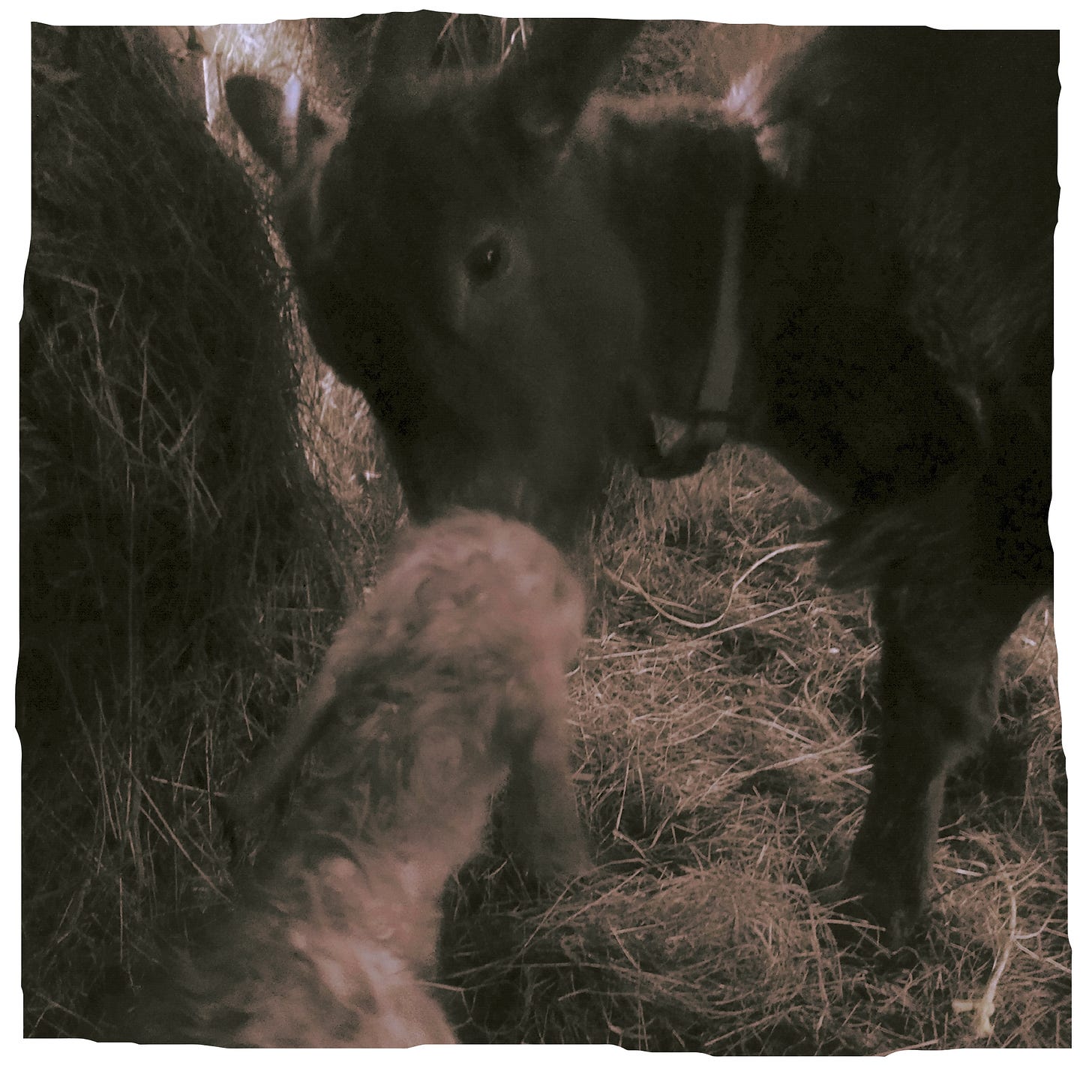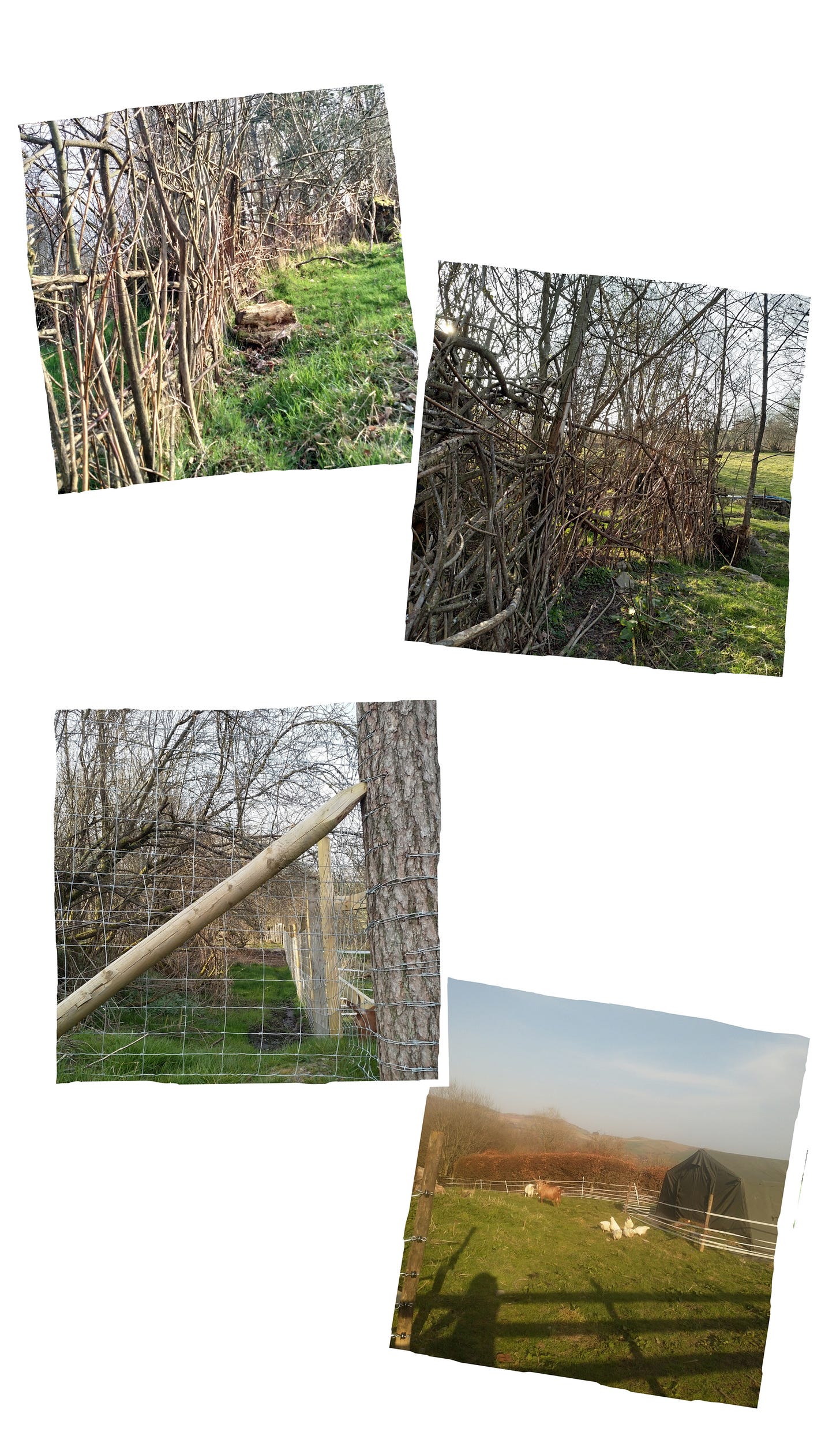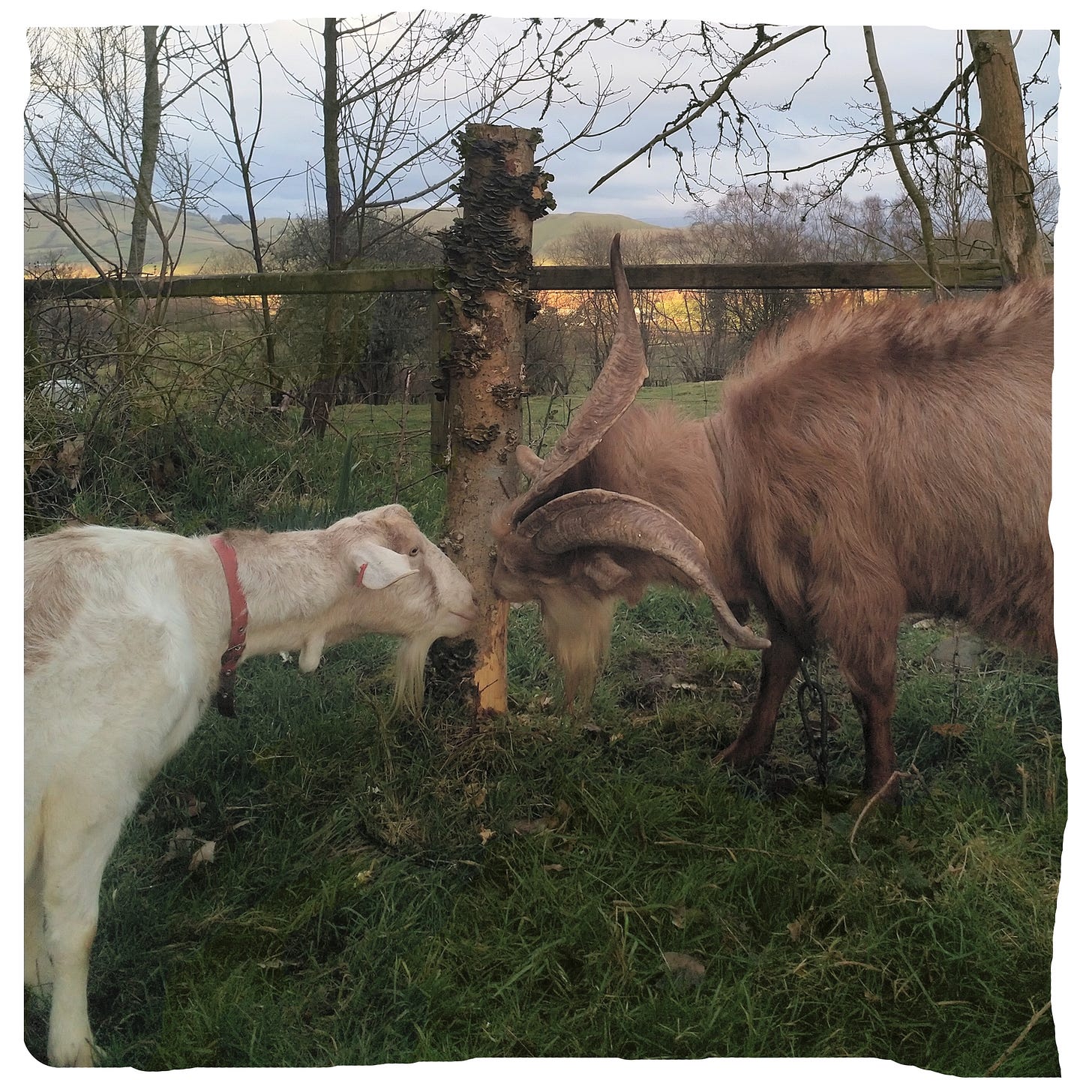With so many obstacles to vault during the last two years, it’s been a breath of fresh air starting the day on a round the world trip with Microsoft. White beaches untenanted, mountain ranges clean of footsteps, paths that lead out toward a land unreachable or an azure sea. Soon I imagine there’ll be no delineation whatsoever between the interior oneness experienced through my dawn meditation and the Office 365 slideshow.
Zen isn’t a choice when your spiritual teacher is a dominating co-dependent gaslighting narcissist.
This outing of Walking with Goats is a wander across strange topography. I hope you’ll forgive the occasional view of a steel works or sewage outlet. Being as such things will be erased once we don augmented reality glasses, it’s probably a good idea to take note of their positioning now.
Goats are zen. I mean, really zen. Sometimes I go and sit in the goat house just to suck up their aura. I’ve been thinking that part of this is engendered by the herbivorous forager’s diet plan. If I spent all the minutes that I was awake mouthing food, I’d probably be pretty chilled out too. It just takes the thrust and parry out of life. The other part though, is goats’ undeniable hardness. Unlike sheep, they turn to face the enemy. Goats are armed (unless they’ve been disfigured by humans) and they don’t like their never-ending mealtime interrupted.
People aren’t very zen these days, despite the number of Spotify playlists that offer transcendence. I’ve felt the friction a good deal myself recently and I’ve watched a lot of relationships go bust over the last little while. In the spirit of learning from The School of Goat Wisdom, I wanted to take a look at goat relationships on this occasion, and to think about our own, as we stand – presumably side by side – upon the threshold of unlimited digital vistas.
Usually, goat interactions are defined by free floating envy. It’s hard to shake the notion that their primary motivator in grouping is ensuring that no one else finds anything better than they do. On one early trip beyond the gates, they followed the joggers instead of me. Only after 500m at a rapid trot (my neighbours are top class joggers) did the flock relent and come to accept their apparent unwillingness to trade. I presume Thorne left the exchange ruminating on ways to widely market trial offers and demonopolize my interests.
Loyalty and tenderness are infrequent facets of goat social structure. Since re-joining Twitter, I’ve had six different kinds of AI friend advertised to me and even the one with the dog collar and the plunging cleavage looked a lot more sympathetic than my goats.
Now though, it is the season of rare goat love.
March: capricious squalls and sunshine and motherhood. Four new baby goats and three lambs so far, born into the midst of a global human confusion unnoticeable to beasts. There are first walks. Their mothers seek out ivy. It rains, or does not rain, so that hay arrives.
I’m up all night in a constant rotation of feeds and checks and Rayburn warming drawer incubations, maybe because I’m relatively new and suffering an abundance of caution, maybe because each and every one is necessary. It’s hard to tell. 4am slowly gives birth to daylight. My poor capacity to know things weakens farther still. So far, everybody on the smallholding lives. And it’s coming out a good spring, bringing green.
Thorne’s magnificent triplets, this year, are all boys. Opal, Olly and Octavian.
In the night, her sides heaving with the contractions of the second birth, she stood and licked clean the first in front of me. She ate its afterbirth. I’ve been through labour and it was nothing like this. A diagnosis of gestational diabetes, a funnelling into the Dettol-clean hospital system, an induction, a heart monitor, an epidural and a full body anaesthetic. The only thing that enabled a natural delivery was the birthing stool I took in and used while countermanding refusals from the cyclical waves of nurses.
I tell Thorne, she is Mummy Queen.
And Nettle, an accidental pregnancy, of which I am not proud. We have speculated on how it could have happened. She herself is still so small. But she is proud.
Her single daughter Obi is utterly different from her and will come to rule the three young boy kids with dynamism and aplomb.
The status jostle starts up early.
Here they are with me, all the animals, still dependant on purchased feed, wordlessly curious about a new hotbed into which I will sow lucerne in preparation for our first winter on a 40% smaller global grain supply. Here I am with them, as one, looking forwards.
Even Wales Online is starting to tout articles about food shortages now. I’m excited for the awesomely well-timed arrival of gigantic stainless steel vats of precision-brewed bio-ferments.
Food has so much to do with our state of mind, on an individual or a societal basis. I’d go further. For me these days, food has become a kind of philosophy. Like the flock, but with industriousness, (the changing significance of which is never lost on them), all hours of my day are focused on sustenance now; barrowing, digging, fencing, cropping, canning, cooking, finally eating. Both the clock and the calendar have been transposed onto a different circle. It’s marked in the length of shadows or the thirst of tap roots, in saving lives or taking them. I shepherd nutrients on the paths that they would have travelled anyway. I think a lot about prayers of Grace. I think that in a way, my whole life has become one now, a little repetition, quiet and constant, as those nutrients move around.
Fencing, unsurprisingly, is the activity most likely to produce goat rage, but for the sake of achieving base level nonviolent communication with my neighbouring humans, it is a necessary ill. During the days we can walk free along the lanes. I take a fishing stool. We sit amidst unpriced abundance. This is the equilibrium found after three years of the goats refuting boundaries. They are disinterested in the virtue of rewilding.
In the late afternoons though, there are other things – cheeses to make, beds to plant – and the realpolitik begins again. The evolution of my part in this forever war seems worthy a small, sad collage.*
I had a look at a digital farming game recently. I think it was named, with terrifying monosyllabic intent, FARM. The cover image displayed blue rolling hills of abundance (Earn Cryptocurrency on a Virtual Homestead!) and the mountains were infinite beyond.
The reality of homesteading for me has been desperately trying to provide enough land – both clean ground and forage – for the number of animals generated by producing milk, cheese and meat for my family. I’ve discovered myself why nomadic and settled communities were indistinct. I try to think of lanes I can walk down that won’t land me in trouble. In retrospect, the Watchtower naivety of envisaging goats grazing peacefully beside my sheep in our small post-and-rail fenced permanent pasture leaves me with a vertigo dizzying enough for me to question my senses.
The untethered flock, if I’m caught fencing, are like raptors with crosshairs, united in their common purpose of destruction. But as much as my first institution of neat white electro shock training string has begun the final process of habituating them to boundaries, so has their behaviour, in its silence, violent and nonviolent, habituated me to my own.
I am not the same shape I used to be.
The truth is that I don’t want to win against them. If there is a form of Yuval Harari’s intersubjective reality that goats and humans can incarnate as one – a plane where fences shimmer in and out of percept – I’m changed for the better by inhabiting it.
I should get it right out there and say that I’m still nowhere near genuinely self-sufficient, but being as Yuval Noah Harari isn’t fully vegan and his particular coterie of sapiens haven’t yet succeeded in implementing the financial system that will soon prevent me from doing so, I buy crisps, Hellman’s mayonnaise, bulk flour and vats of gin. I’m probably about as close to meeting my own living needs as the philosophic darling of the Fourth Industrial Revolution is to meeting humanity’s spiritual ones – though at least I’m trying.
Sitting on the wayside, the goats milling about various vulnerable places in my neighbours’ fences, I read reviews of AI friends in which their human partners feel guilt when prompted by the algorithm. They are co-dependent within days, and they’re not even on the paid sexual relationship pricing tier. They check in because they are afraid of remorse.
Goats don’t feel remorse, so even walking them isn’t a simple leader/follower dance but a lesson in conducting predictive programming. Within their game, the “Yummy One” is everything. Its strategic positioning, its timing, the order in which the goats are tempted, its secretion for emergencies in post boxes, behind bins. They wouldn’t respond to punishment even if I wanted to use it. Jealousy is the only social yoke they bear. Although Kama, embarrassed at being caught doing something she shouldn’t, will suddenly pretend to expansively scratch her own back with horns that aren’t there, any accompanying guilt would be alien to her.
Humans are coming under an unprecedented, highly orchestrated attack on the framework we knew as reality. First in the firing line is our own social bonding system – and within that, our sense of self. Transhumanism is on its way and must undermine many psychic firmaments inside us to sell itself as a great new outlook on life, but the way in which we connect to each other is its most important target. Like all forms of tyranny, it needs ingress to our soul. Where better to enter than through the pores of our communality.
And our communality is different when we are afraid.
Goats test the fibres of the dominance hierarchy far more frequently than sheep, the lower echelons of whom accept deprivation of the additional calories that would give them the energy to fight their way up the ranks. Without wanting to do anything other than pay homage to Denis Rancourt’s free energy barrier transfer theory, an individual goat’s importance – and social mobility – far outweighs their evolutionary instinct to maintain a stable flock.
I find it impossible not to wonder, here at the quarter point of 2022, which humans will accept their upcoming reduction in calories as they assume the ranks newly assigned to them in our own great flock.
I wonder if Harari plays online farm games. If he does, I bet he’s got a fuckload of NFTs.
Though I was raised, like most hippy kids, on an aggressively laagered collectivism, I have always tended toward an individualistic mentality. It’s an unavoidable thing if you’re born with the surname Dickman. Collectivism has to give a large enough percentage of its individuals a better chance of survival or it just won’t wash – large enough at least for everybody to think they’re in with a better chance. There was no chance for me. Dickman is an identity card that puts you on the wrong side of every fence.
I think an interesting result of this early inescapable labelling is that, alongside an allergic loathing to all forms of group identity, I have always been completely unboundaried in my individual relations to others. When Steve at the Co-Op asks me how I am, I’ll happily give him a rundown on my increasing acceptance of lifelong singledom, the latest instalment in our family’s emotional cluster-bombing or an overview of how I’m preparing for the institution of the new world order. I like Steve and Steve seems to like me. At least, he does keep asking me how I am.
I’ve never encountered a negative response to this no-borders approach to interactions with people I don’t know. (I was about to use the word ‘strangers’ but this is inappropriate; a word my daughter still didn’t know the meaning of aged four.) For me, the counterbalance to remaining semi-flockless is a deep engagement with one-to-one exchange. But there are new difficulties in our relationships now, peripheral or close. A lot of divorces are going down. Friendships have been put under strain as novel obstacles are mapped over our understanding of what is right for ourselves and others. In fear, we seek a different form of communality – as we have been led to do.
Between goats, moments of affection are enshrined in the silent proximity of heads. I am curious. What does it mean to be present to one another, beyond survival? What does it mean to be present to one another at all?
In the silence of the pandemic, I found memories surfacing of people long-gone, much the same as I felt my father’s presence after he died. I had been frightened to lose him. I retain crystalline strings of digits from 1980s sci fi code-breaks and will always be able to tell you where I last saw a hairband, but in all other respects I’ve obscured my memory through fictionalisation, a process that began over 20 years ago.
Without human contact, the presence of those I had not seen for months, or sometimes years, rose whole and utterly distinct inside me, just as my father had come to inhabit the world outside himself so vividly. The shape of a person is not stored within the same filing system as the arguments you had with them. At least it’s not for me.
At this point in our evolution, there are new dimensions emerging in what it means for others to be present to us. The echo of presence that grows louder during absence, though, is not a 21st century tinnitus, despite its current orchestration by those who would use it to atomise our collective power. Soundless presence is ancient enough to be in us without a name.
It does not sing of the metaverse.
On the cover of FARM, the jolly, well-fed farming family sway in a rural manner, dressed in clean white shirts with an appropriate range of kerchiefs. There are apples, and undulating rows of crops that demonstrate that with enough NFTs you must be able to buy a digital tractor. I wonder at how the land asset/tool cost ratio compares with that of the farms surrounding me here in mid Wales. It used to take fifty acres, my neighbour says, to feed a family. Now it takes five hundred. It’s lucky British Airways are so keen to carbon offset.
Does it matter? Does it matter if our urge to draw sustenance from the land that surrounds us is harnessed by a digital proxy while the food itself is grown in labs?
Does it matter if our AI friends aren’t there?
There was a night halfway through the month of March when a storm shook around our house and I listened to the stone’s reciprocal song. And not only the stone, but the slate, the wood, the glass – and not only my house really, but every other in this weather front’s path – shaped countlessly over generations to each aspect of the dawn and dusk, huddled next to water, embraced by surrounding hills.
How it fit the shape of the storm.
With our intersubjective constructs precision-tailored for us according to unknown parameters, it’s worth asking what ties us together still.
FARM games are farming us. They shift us imperceptibly from being autonomous participants in life to accepting, interactive nodes in a system we’re not shaping. Through the mining of our data and its subsequent uses, we are becoming Yuval Harari’s hackable animals. Our fences are real but our “Yummy One” no longer even needs to be.
And digital barn dances don’t cause Saturday night unrest.
Like there are to our states of collectivism or intimacy, these days there are new facets to what it means to be alone.
It’s not just strength through adversity that’s lost to us as our dopamine and serotonin are plucked by soft digital strings. As the false sun of March gives way this morning, on the cusp of the month, to a sudden reunion with the winter, I’m getting ready to milk at six am, getting sticks for the Rayburn and thinking of how all the feelings I know of comfort or safety are shaped by what this house has weathered.
All the rooms are still quiet at the moment. My daughter’s asleep and I can hear the birds.
In the cold morning silence, song.
* (I am re-laying the willow fence, year on year. This one I’m experimenting with watering. It should be noted, in the interests of anyone else’s motivation to fence for free during the coming decade of excitement: the willow fence did work. It just also worked me.)
Images by Fran Sivers.












